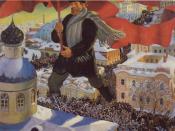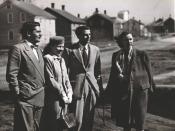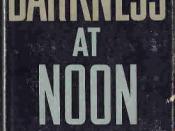BOOK REPORT DARKNESS AT NOON
Darkness at Noon by Arthur Koestler is a fiction story, which depicts the life of what appears to be a Bolshevik member during the revolutionary periods of Russia. Although the author doesn't name the country where the story line takes place nor does he give real names, it's pretty obvious Koestler is writing about Russia (Country of the Revolution), Stalin (Number One), Lenin (the old man with the slanting tartar eyes) and the Revolutionary period of the late 1930s. The main character, N. S. Rubashov, a victim of Stalin's (Number One) rule of terror is imprisoned after being captured in an apartment building. Rubashov is portrayed as a hard-core Party member who has served various years in other prisons and has learned about life through the hard knocks system.
Rubashov who at one time dedicated his life to the Party is now facing the irony of its pragmatism.
While in prison, Rubashov learns there are other political prisoners being maintained in the cells next to him. In particular prisoner number 402 and Rubashov carry on conversations by using the "quadratic alphabet" (Darkness at Noon, p. 19), better known as wall tapping. During Rubashov's interaction with the other prisoners, Rubashov learns of how the prison system works and receives an understanding of the other prisoners' background.
Rubashov spends the majority of his prison time reminiscing about his own encounter with the Party, those who he influenced and those who he betrayed. Rubashov is continuously smoking, writing, complaining of a sore tooth and fidgeting with his pince-nez. Some of the major characters that Koestler concentrates on are Little Lowey a Dutch dockworker, Richard, Arlova, Ivanov and Gletkin who eventually tortures Rubashov to the confession of a political crime that he possibly never committed. Rubashov is deprived sleep,



Obvious errors, did you read the book?
A)"depicts the life of what appears to be a Bolshevik member during the revolutionary periods of Russia" - This was many years after the revolution, it was the Russian Communist Party at this point
B)"is a fiction story" - It is based on the authors real life experiences
C)"During Rubashov's interaction with the other prisoners, Rubashov learns of how the prison system works" - He was in prison for years, he knew how it worked.
D)"forced to hear made-up testimony from an individual who he's never spoken with" - He eventually realizes it was the truth.
E)"this book could have been shorten to get its message across...communist is a bad thing" - The reason he dies in the end is because he wants communism to succeed, it is a message against the party not communism
Also the grammar errors are atrocious, you got an A as a college senior with this paper?
0 out of 0 people found this comment useful.